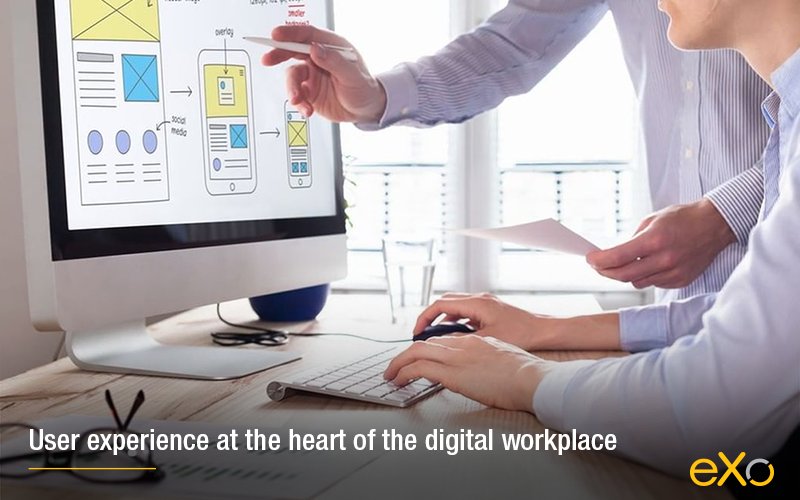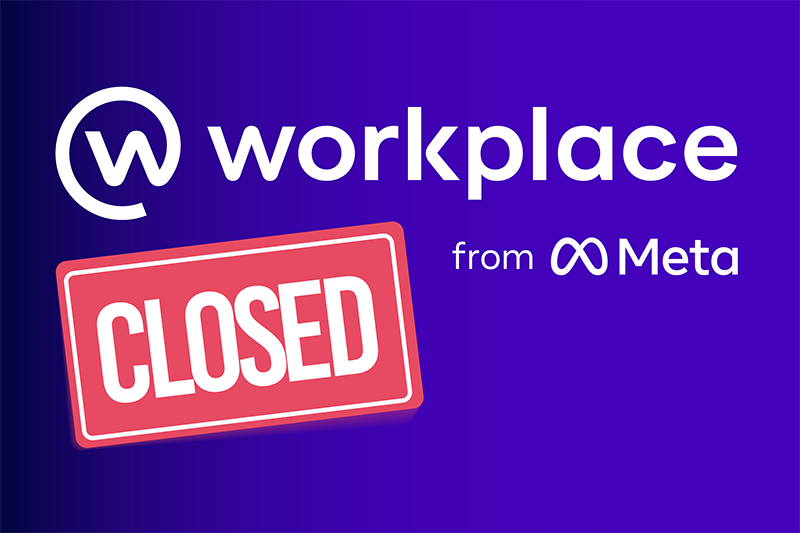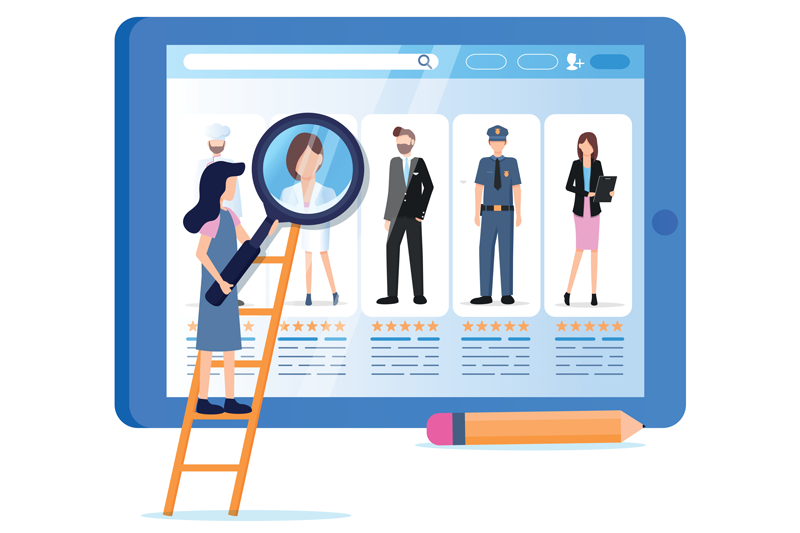- Brahim Jaouane
- October 17, 2019
How to improve your digital workplace through user experience?
Imagine you download an app to order food, you open the app, but you don’t seem to figure out how the thing works. One of your reactions will probably be “I am too old for this staff” or maybe “How come all my friends can use it but not me?”. Although getting used to new technologies is a bit challenging at first. In most cases, if we fail to use an app or a software, it is probably because it has a poor UX design.

Content
Ever since the turn of the century, apps became a thing. There are apps for virtually anything we do daily.
You want to connect with friends and family?… there is an app for that. Order food?… There is an app for that. Fall in love?… There is also an app for that.
The increasing popularity of consumer apps and software, meant that it was only a matter of time until businesses started to adopt similar solutions in the workplace. Today, there is a multitude of tools and business specific applications that employees can use to communicate, collaborate and get things done.
The popularity of the apps and tools we use is primarily due to their convenience and their ability to get things done fast. But if we had a hard time figuring out how these apps work, we would have rejected them and stuck with what we already had. This is when UX design comes into play.
1. What is UX design
As found on wikipedia,
“User experience design (UX) is the process of manipulating user behavior with a product by using data to inform the design process and continual updates to the usability, accessibility, and desirability provided in the interaction with a product”.
In simple terms, UX refers to how your employees engage and interact with the product and whether it is useful for them. If the product is self-explanatory and user friendly, then it would be a hit among users. If not, it would most certainly fail.
The term UX originated in the late 1990’s by Don Norman, a cognitive scientist and co-founder of the Nielsen Norman Group Design Consultancy. The fact that term is relatively new mean that it will eventually be misunderstood and confused with other concepts.
There is often confusion between UX and UI. UI design refers to user interface and it is basically the look and style of the solution. UX and UI are interdependent but not interchangeable. Both elements are crucial to the success of a product. A failure to do one or the other can have a significant impact on the usage and adoption of a solution.

FREE WHITE PAPER
The Complete
Guide to
Employee Engagement
Guide to
Employee Engagement
There are many definitions for the concept of employee engagement out there.
2. Why UX is important
Let us take the example of John. John has just joined his new company and is getting started to use the digital workplace. Having been used to popular apps like Facebook and Twitter, he is expecting a solution more or less similar in terms of usability and navigation.
But what he found was something like he has never seen before. A layout that is not clear, no dashboard connected to the main apps, no activity stream with the latest activities, basic profile pages and the list goes on. This eventually led John to stop using the digital workplace and choose other tools to communicate with his peers and perform his daily activities like e-mail or even his own social media accounts.
John’s situation highlights perfectly the impact of having a bad digital workplace UX design. Because UX is one of those things that you only notice when it is not there not the opposite. This is why, UX and UI need to take center stage in the process of building a digital workplace to guarantee high levels of adoption and engagement and eventually a better business performance.
3. How to assess your digital workplace UX?
Before planning to implement a new digital workplace, it is important to identify and measure what is going wrong first. To achieve that, you need to measure the metrics that have a direct impact on the success of the project.
There is a number of ways you can use to conduct these measurements:
Direct feedback
Feedback is a straightforward way to identify areas of improvements. At the end of the day, employees are at the heart of the digital workplace which makes their opinion all the more important.
Quantitative research surveys can be conducted to rate the level of engagement and satisfaction. The questions can be included in the homepage of the digital workplace with questions like “How much are you satisfied with the digital workplace overall/ or specific feature?” and “How would you feel if we introduced a specific feature to the digital workplace?”.
You can take the survey a step further by including open ended questions to let your employees express their opinion freely.
Comparative analysis
This is a measurement of the performance of a digital workplace before and after UX improvements. For example, if changes were brought to the task management functionality, a simple measure of the number of tasks created before and after the changes can be a great indicator of the success of the UX improvements.
Another example may include changes brought to the way users navigate the homepage, how apps are regrouped and how links are displayed. A comparison of the number of likes, comments and shares before and after the changes can indicate whether the changes are bearing results.
Although gathering the feedback of employees and monitoring their behavior is crucial to determine areas of improvements, it is not enough to guarantee a better user experience. In a Digital Workplace Impact podcast, Paul Boag stated just that.
“One of the first things you learn when you get into user experience design is that facilitating the needs of users isn’t just asking them what they want and then doing it. Some users can’t picture or imagine a better way.”
4. Proven UX practices
Put the user at the center of the digital workplace
Every successful app or software solution is carefully tailored to fit the user’s needs. This is why, whenever you open Facebook or Linkedin, you often come across the same basic principles. A news feed, a dashboard containing your connections, upcoming events etc and a topbar for easy navigation. Digital workplace solutions are progressively adopting these same UX techniques because, first they are proven techniques that work, and second and most importantly, employees are used to them. This makes the adoption easier and users more engaged.
Going back to the John example mentioned earlier, it would have been a completely different story if he had a digital workplace that is clear, visually appealing and most importantly easy to navigate and inspired from consumer technologies he uses in his everyday life.
Give users power to customize
To guarantee high engagement rates, digital workplace solutions are betting on UX and UI techniques that will allow users to personalize the solution based on their needs. For example, users can have the possibility to follow certain people, groups or hashtags to display on the news feed. This way they will only have the information and activities relevant to them.
Another example may consist of users changing the layout of their profile page and their personal dashboard to only display apps and activities they work on regularly without the need to individually checking each app.
Continuous assessment and testing
As mentioned earlier, listening to employees is extremely important to provide them with the right digital workplace solution. Once implemented, the solution can be the playing ground for your employees especially communication specialists and UX designers to test it and make adjustments accordingly. Some behaviors can be changed for a certain period of time to assess whether they have a desirable effect on usage all while taking into account a set of pre-defined metrics.
The decision to implement a digital workplace solution is driven by a number of important factors. Ease of use and visual appeal are often top of the agenda for both companies looking to implement a digital workplace and solution providers alike.
Both UX and UI design techniques are evolving with each year passing thanks to advancements in consumer technologies. Businesses and tech companies have to keep up to provide their workforce with the apps they expect and deserve. Luckily, a product design company can easily help you improve your platforms with the latest design trends and technological solutions.
If you would like to learn more about the topic of UX and the digital workplace I suggest you listen to the Digital Workplace Impact podcast titled “Real-world usability in the modern digital workplace” and take a tour of our blog for more related topics.
Transform your employee experience
with eXo Platform
with eXo Platform
4.9/5 - (37 votes)
I am a Digital Marketing specialist specialized in SEO at eXo Platform.
Passionate about new technologies and Digital Marketing.
With 10 years' experience, I support companies in their digital communication strategies and implement the tools necessary for their success.
My approach combines the use of different traffic acquisition levers and an optimization of the user experience to convert visitors into customers.
After various digital experiences in communication agencies as well as in B2B company, I have a wide range of skills and I am able to manage the digital marketing strategy of small and medium-sized companies.
Related posts
- All
- eXo
- Digital workplace
- Employee engagement
- Open source
- Future of work
- Internal communication
- Collaboration
- News
- intranet
- workplace
- Knowledge management
- Employee experience
- Employee productivity
- onboarding
- Employee recognition
- Change management
- Cartoon
- Digital transformation
- Infographic
- Remote work
- Industry trends
- Product News
- Thought leadership
- Tips & Tricks
- Tutorial
- Uncategorized
Leave a Reply
( Your e-mail address will not be published)
Connexion
0 Comments
Commentaires en ligne
Afficher tous les commentaires


